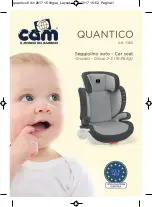
Passive Restraints
49
Lap Belt with Motorized Shoulder Belt
(fig. e)
DO NOT
use with any car seat.
- See your vehicle dealer for available hardware or options for securing a child
restraint in this location.
(fig. e)
Lap or Shoulder Belt Mounted on Front Door
(fig. f)
DO NOT
use a car seat in any front seating location that has belts mounted
to the front door. Belts will not stay tight while driving.
- See your vehicle dealer for available hardware or options for securing
a child restraint in this location.
(fig. f)
Front
Door
Pull out on latch plate. If belt slides freely through latch plate
(fig. g)
, the locking
clip MUST be used (see “Locking Clip” section).
- Use the locking clip to secure the lap belt around the base or the car seat
(see “Locking Clip” section).
Some combination lap/shoulder belts with free sliding latch plates may be
converted into an “automatic locking mode”. Always use the belt lock-off with
these belt systems.
(fig. g)
Combination Lap/Shoulder Belt with Free Sliding Latch Plate
50
Vehicle seat belts with locking latch plates
(fig. h)
normally hold a car seat
tightly. However in some cases, the locking latch plate on some seat belts
may slip and loosen after being buckled on car seat if positioned at a certain
angle. If this happens, flip the latch plate over and re-buckle. Test installation
again to see if this works. If not, move car seat to another seating location.
(fig. h)
Combination Lap/Shoulder Belt with Locking Latch Plate
Flip





































